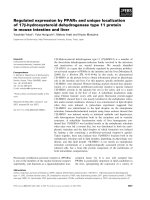Lecture Retail and merchant banking – Lecture 17
Bạn đang xem bản rút gọn của tài liệu. Xem và tải ngay bản đầy đủ của tài liệu tại đây (4.17 MB, 33 trang )
Revise Lecture 17
•
Basic Lending
Principles
Basic Lending Principles
•
According to section 6 of the Banking
Regulation Act, 1949, banking means
‘accepting for the purpose of lending or
investment of deposits of money from the
public, repayable on demand or otherwise
and withdrawable by cheque, draft, order or
otherwise’.
Basic Lending Principles
•
•
Another major reason of the lending
function is to add value to the bank.
By lending the funds mobilized by it, a
bank will be in a position to earn spreads
to sustain profitability.
Basic Lending Principles
•
•
Profitability through lending will be
obtained if the bank is in a position to take
and manage credit risk that arises on
account of the quality of the borrower and
liquidity risk that may arise by borrowing
short and lending long in order to attain
greater spreads.
Further, the spreads earned in this activity
will also be exposed to risk arising from
both interest and exchange rates.
Basic Lending Principles
•
Thus, while lending, the bank should try to
balance its spreads and the risk levels.
•
Liquidity
Basic Lending Principles
Liquidity:
•
•
•
Liquidity for a bank means the ability to
meet its financial obligations.
A bank lending finances invests in
relatively illiquid assets, but it funds its
loans with mostly short-term liabilities.
A shortage of liquidity has often been a
trigger for bank failures.
Basic Lending Principles
•
•
•
•
Liquidity:
Holding assets in a highly liquid form
tends to reduce the income from that asset
(cash, for example, is the most liquid asset
of all, but pays no interest).
So banks try to reduce liquid assets as far
as possible.
However, a bank without sufficient liquidity
to meet the demands of its depositors
Basic Lending Principles
•
•
•
Liquidity:
The result is that most banks now try to
forecast their liquidity requirements and
maintain emergency standby credit lines at
other banks.
Banking regulators also view liquidity as a
major concern.
Lecture 18
•
Asset management
banking
Basic Lending Principles
Asset management banking
•
•
•
One of the main challenges to a bank is
ensuring its own liquidity under all
reasonable conditions.
Commercial banks differ widely in how
they manage liquidity.
A small bank derives its funds primarily
from customer deposits. Its assets are
mostly loans to small firms and
Basic Lending Principles
Asset management banking
•
•
Excess funds are typically invested in
assets that will provide it with liquidity.
The holding of assets that can readily be
turned into cash when needed is known as
asset management banking.
•
Liability management
banking
Basic Lending Principles
Liability management banking
•
In contrast, large banks generally lack
sufficient deposits to fund their main
business dealing with large companies,
governments, other financial institutions
and wealthy individuals.
Basic Lending Principles
Liability management banking
•
•
Most of these banks borrow the funds they
need from other major lenders in the form
of short-term liabilities which must be
continually rolled over.
This is known as liability management,
A much riskier method than asset
management.
Basic Lending Principles
Liability management banking
•
•
A small bank will lose potential income if it
gets its asset management wrong.
A large bank may fail if it gets its liability
management wrong.
Basic Lending Principles
Liability management banking
•
•
•
The key to liability management is the
ability to borrow always.
Therefore, a bank’s most vital asset is its
creditworthiness. If there is any doubt
about its credit, lenders can easily switch
to another bank.
The rate a bank must pay to borrow will go
up rapidly with the slightest suspicion of
Basic Lending Principles
Liability management banking
•
In recent years, large banks have been
making increasing use of asset
management in order to enhance liquidity,
holding a larger part of their assets as
securities as well as securitizing their
loans to recycle borrowed funds.
Basic Lending Principles
Liability management banking
•
•
•
A ‘bank run’ is an overwhelming demand
for cash by a bank’s depositors.
A large depositor assumes a risk and
needs to know something about the bank’s
own balance sheet.
However, a healthy balance sheet does
not eliminate all risks.
Basic Lending Principles
Liability management banking
•
•
Even if the depositor knows the bank has
adequate liquidity.
Large depositors must, therefore, be
concerned about what others are likely to
believe. A rumour a bank, even though
unfounded, can trigger a run causes a
solvent bank to fail.
Basic Lending Principles
•
Profitability
Basic Lending Principles
Profitability
•
•
A bank generates profit from the
differential between the level of interest it
pays for deposits and other sources of
funds and the level of interest it changes
in its lending activities.
This difference is referred to as the
SPREAD between the cost of funds and
the loan interest rate.
Basic Lending Principles
Profitability
•
•
Historically. Profitability from lending
activities has been cyclic and dependent
on the needs and strengths of loan
customers.
In recent history, investors have
demanded a more stable revenue stream
and banks have therefore, placed more
emphasis on transaction fees, primarily
loan fees, but also including services









